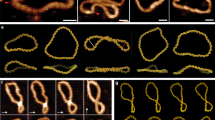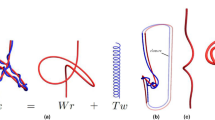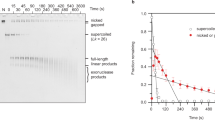Abstract
DNA winds about itself in a right-handed or left-handed fashion at several structural levels. The double helix is generally right-handed and is given a (+) sign by convention, whereas supercoiling of the helix axis is always (−) in the cell1,2. The winding in higher -order forms such as knots and catenanes is unknown, and this has impeded elucidation of the mechanisms of their formation and resolution by replication, recombination and topoisomerase action3–6. We introduce here a procedure for determining the handedness of DNA winding by inspection of electron micrographs of DNA molecules coated with Escherichia coli RecA protein. We demonstrate the validity of the method and show that DNA topoisomerase I of E. coli7 generates an equal mixture of (+) and (−) duplex DNA knots, and that one product of recombination by resolvase of transposon Tn3 (refs 8, 9) is a catenane of uniquely (+) sign.
This is a preview of subscription content, access via your institution
Access options
Subscribe to this journal
Receive 51 print issues and online access
$199.00 per year
only $3.90 per issue
Buy this article
- Purchase on Springer Link
- Instant access to full article PDF
Prices may be subject to local taxes which are calculated during checkout
Similar content being viewed by others
References
Crick, F. H. C., Wang, J. C. & Bauer, W. R. J. molec. Biol. 129, 449–461 (1979).
Dickerson, R. E. et al. Science 216, 475–485 (1982).
Sundin, O. & Varshavsky, A. Cell 21, 103–114 (1980).
Mizuuchi, K., Gellert, M., Weisberg, R. A. & Nash, H. A. J. molec. Biol. 141, 485–494 (1980).
Liu, L. F., Liu, C. C. & Alberts, B. M. Cell 19, 697–707 (1980).
Kreuzer, K. N. & Cozzarelli, N. R. Cell 20, 245–254 (1980).
Wang, J. C. & Liu, L. F. in Molecular Genetics Pt III (ed. Taylor, J. H.) 65–88 (Academic, New York, 1979).
Reed, R. R. Cell 25, 713–719 (1981).
Krasnow, M. A. & Cozzarelli, N. R. Cell 32, 1313–1324 (1983).
Radding, C. M. Cell 25, 3–4 (1981).
McEntee, K. & Weinstock, G. M. The Enzymes 14 a, 445–470 (1981).
Di Capua, E., Engel, A., Stasiak, A. & Koller, Th. J. molec. Biol. 157, 87–103 (1982).
Dean, F. et al. Cold Spring Harb. Symp. quant. Biol. 47, 769–777 (1983).
Ogston, A. G. Nature 162, 963 (1948).
Stasiak, A. & Di Capua, E. Nature 299, 185–186 (1982).
Arcidiacono, A., Stasiak, A. & Koller, Th. Proc. 7th Eur. Congr. on Electron Microscopy 2, 516–523 (1980).
Hudson, B. & Vinograd, J. Nature 216, 647–652 (1967).
Author information
Authors and Affiliations
Rights and permissions
About this article
Cite this article
Krasnow, M., Stasiak, A., Spengler, S. et al. Determination of the absolute handedness of knots and catenanes of DNA. Nature 304, 559–560 (1983). https://doi.org/10.1038/304559a0
Received:
Accepted:
Issue Date:
DOI: https://doi.org/10.1038/304559a0
This article is cited by
-
Complex DNA knots detected with a nanopore sensor
Nature Communications (2019)
-
Topological transformations in proteins: effects of heating and proximity of an interface
Scientific Reports (2017)
-
Creating complex molecular topologies by configuring DNA four-way junctions
Nature Chemistry (2016)
-
Direct observation of DNA knots using a solid-state nanopore
Nature Nanotechnology (2016)
-
Topological chirality of a type of DNA and protein polyhedral links
Journal of Mathematical Chemistry (2015)
Comments
By submitting a comment you agree to abide by our Terms and Community Guidelines. If you find something abusive or that does not comply with our terms or guidelines please flag it as inappropriate.



